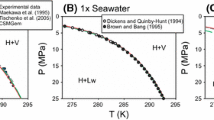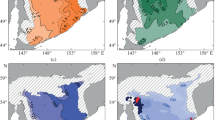Abstract
Using an approximately analytical formation, we extend the steady state model of the pure methane hydrate system to include the salinity based on the dynamic model of the methane hydrate system. The top and bottom boundaries of the methane hydrate stability zone (MHSZ) and the actual methane hydrate zone (MHZ), and the top of free gas occurrence are determined by using numerical methods and the new steady state model developed in this paper. Numerical results show that the MHZ thickness becomes thinner with increasing the salinity, and the stability is lowered and the base of the MHSZ is shifted toward the seafloor in the presence of salts. As a result, the thickness of actual hydrate occurrence becomes thinner compared with that of the pure water case. On the other hand, since lower solubility reduces the amount of gas needed to form methane hydrate, the existence of salts in seawater can actually promote methane gas hydrate formation in the hydrate stability zone. Numerical modeling also demonstrates that for the salt-water case the presence of methane within the field of methane hydrate stability is not sufficient to ensure the occurrence of gas hydrate, which can only form when the methane concentration dissolved in solution with salts exceeds the local methane solubility in salt water and if the methane flux exceeds a critical value corresponding to the rate of diffusive methane transport. In order to maintain gas hydrate or to form methane gas hydrate in marine sediments, a persistent supplied methane probably from biogenic or thermogenic processes, is required to overcome losses due to diffusion and advection.
Similar content being viewed by others
References
Makogon Y F, Hydrates of hydrocarbons, Penn Well, Tulsa, Oklahoma, USA, 1997, 1–21
Sloan E D Jr. Clathrate Hydrates of Natural Gases, 2nd ed, Revised and Expandaed, Marcel Dekker, New York, 1990
Song H B. Geophysical Researches on Gas Hydrates (in Chinese). Beijing: Ocean Press, 2003, 224–229
Kvenvolden K A. Potential effects of gas hydrate on human welfare. In: Proceedings of National Academy of Science, USA, 1999, 96:3420–3426
Chen D F, Wang M C, Xia B. Formation condition and distribution prediction of gas hydrate in Qinghai-Tibet Plateau permafrost, Chin J Geophys (in Chinese), 2005, 48(1): 165–172
Nisbet E G, Piper D J W. Giant submarine landslides. Nature, 1998, 392: 329–330
Bain S, Corfield R M, Norris R D. Mechanisms of climate warming at the end of the Paleocene. Science, 1999, 285: 724–727
Song H B, Geng J H, Wang H K, et al. A preliminary study of gas hydrates in Dongsha region north of South China Sea. Chin J Geophys (in Chinese), 2001, 44(5): 687–695
Holbrook W S, Hoskins H, Wood W T, et al. Methane hydrate and free gas on the Blake Ridge from vertical seismic profiling. Science, 1996, 273: 1840–1843
Dickens G R, Quinby-Hunt M S. Methane hydrate stability in pore water: A simple theoretical approach for geophysical applications. J Geophys Res, 1997, 102: 773–783
Egeberg P K, Dickens G R. Thermodynamic and pore water halogen constraints on hydrate distribution at ODP Site 997 (Blake Ridge). Chem Geol, 1999, 153: 53–79
Paull C K, Matsumoto R, Wallace P J, et al. Proceedings of the Ocean Drilling Program, Scientific Reports, College Station, Texas (Ocean Drilling Program), 2000, 164: 1–459
Xu W, Lowell R P, Peltzer E T. Effect of seafloor temperature and pressure variations on methane flux from a gas hydrate layer: Comparison between current and Late Paleocene climate conditions. J Geophys Res, 2001, 106: 26413–26423
Yu X G, Li J B, Gong J M, et al. Stable carbon and nitrogen isotopic composition of gas hydrate-bearing sediment from Hydrate Ridge, Cascadia Margin. Sci China Ser D-Earth Sci, 2006, 49(8): 872–880
Jiang G Q, Shi X Y, Zhang S H. Methane seeps, methane hydrate destabilization, and the late Neoproterozoic postglacial cap carbonates. Chin Sci Bull, 2006, 51(10): 1152–1173
Niu B H, Wen P F, Wen N, et al. Estimation of hydrate concentration based on AVO modeling of BSR. Chin J Geophys (in Chinese), 2006, 49(1): 143–152
Ruan A G, Li J B, Chu F Y, et al. AVO numerical simulation of gas hydrates reflectors beneath seafloor. Chin J Geophys (in Chinese), 2006, 49(6): 1826–1835
Trehu A M, Bohrmann G, Rack F R, et al. Proceedings of the Ocean Drilling Program, Initial Reports, College Station TX, 204, 2003
Ruppel C. Anomalously cold temperatures observed at the base of the gas hydrate stability zone on the US Atlantic passive margin. Geology, 1997, 25: 699–702
Zatsepina O Y, Buffett B A. Thermodynamic conditions for the stability of gas hydrate in the seafloor. J Geophys Res, 1998, 103:24127–24139
Davie M K, Zatsepina O Y, Buffett B A. Methane solubility in marine hydrate environments. Mar Geol, 2004, 203: 177–184
Xu W. Modeling dynamic marine gas hydrate systems. Am Mineral, 2004, 89: 1271–1279
Chen D F, Cathles L M. On the thermal impact of gas venting and hydrate crystallization. J Geophys Res, 2005, 110, B11204, doi: 10.1029/2004JB003533
Collett T S. Well log evaluation of gas hydrate saturations. Trans SPWLA Annu Logging Symp, 39th, 1998, 1–14
Xu W, Ruppel C. Predicting the occurrence, distribution, and evolution of methane gashydrate in porous marine sediments. J Geophys Res, 1999, 104: 5081–5095
Davie M K, Buffett B A. A steady state model for marine hydrate formation: Constraints on methane supply from pore water sulfate profiles. J Geophys Res, 2003, 108(B10), 2495, doi:10.1029/2002 JB002300
Menton P D, Parrish W R, Sloan E D. Effect of inhibitors on hydrate formation. Ind Eng Chem Proc Des Dev, 1981, 20: 399–401
Dholabhai P D, Englezos P, Kalogerakis N, et al. Equilibrium conditions for methane hydrate formation in aqueous mixed electrolyte solutions. Can J Chem Eng, 1991, 69: 800–805
Dickens G R, Quinby-Hunt M S. Methane hydrate stability in seawater. Geophys Res Lett, 1994, 21: 2115–2118
Englezos P, Hall S. Phase equilibrium data on carbon dioxide hydrate in the presence of electrolytes, water soluble polymers and montmorillonite. Can J Chem Eng, 1994, 72: 887–893
Dickens G R, Castillo M M, Wlakern J C. A blast of gas in the latest paleocene: simulating first order effects of massive dissociation of oceanic methane hydrate. Geology, 1997, 25(3): 259–262
Hyndman R D, Spence G D. A seismic study of methane hydrate marine bottom simulating reflectors. J Geophys Res, 1992, 97:6683–6698
Handa Y P. Effect of hydrostatic pressure and salinity on the stability of gas hydrates. J Phys Chem, 1990, 94: 2652–2657
Servio P, Englezons P. Measurement of dissolved methane in water in equilibrium with its hydrate. J Chem Engineer Data, 2002, 47: 87–90
Zatsepina O Y, Buffett B A. Phase equilibrium of gas hydrate: Implications for the formation of hydrate in the deep seafloor. Geophys Res Lett, 1997, 24: 1567–1570
Englezos P, Bishnoi P R. Prediction of gas hydrate formation conditions in aqueous electrolyte solutions. AIChE J, 1988, 34: 1718–1721
Jager M D, Sloan E D. The effect of pressure on methane hydration in pure water and sodium chloride solutions. Fluid Phase Equilibria, 2001, 185: 89–99
Lekvam K, Bishnoi P R. Dissolution of methane in water at low temperature and intermediate pressure. Fluid Phase Equilibria, 1997, 131: 297–309
Yang S O, Cho S H, Lee H, et al. Measurement and prediction of phase equilibria for water + methane in hydrate forming conditions. Fluid Phase Equilibria, 2001, 185: 53–63
Sorensen H, Pedersen K S, Christensen P L. Modeling of gas solubility in brine. Organic Geochemistry, 2002, 33: 635–642
Henry P, Thomas M, Clennell B M. Formation of natural gas hydrates in marine sediments 2: Thermodynamic calculations of stability conditions in porous sediments. J Geophys Res, 1999, 104: 23005–23022
Author information
Authors and Affiliations
Corresponding author
Additional information
Supported by NSF (USA) (Grant No. OCE-0242163) and partially by the National Natural Science Foundation of China (Grant No. 40574014)
Rights and permissions
About this article
Cite this article
Yang, D., Xu, W. Effects of salinity on methane gas hydrate system. SCI CHINA SER D 50, 1733–1745 (2007). https://doi.org/10.1007/s11430-007-0126-5
Received:
Accepted:
Issue Date:
DOI: https://doi.org/10.1007/s11430-007-0126-5




